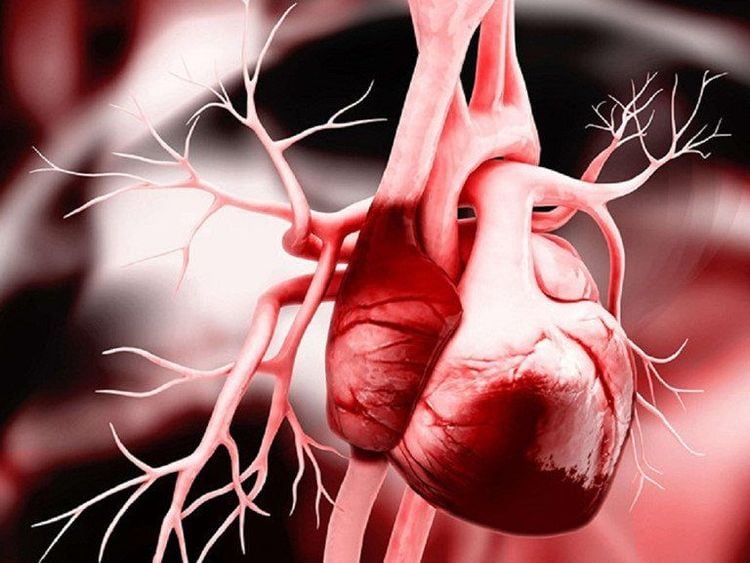This is an automatically translated article.
The article was professionally consulted with Master, Doctor Vu Huu Thang - Resuscitation - Emergency Doctor - Emergency Resuscitation Department - Vinmec Ha Long International Hospital.The mortality rate from cardiac injury is about 15 - 30%, mainly due to acute blood loss or acute cardiac tamponade. Therefore, accurate diagnosis, prognosis and proper and timely management of patients with heart wounds are decisive factors for the patient's ability to save lives.
1. Overview of heart injuries
1.1 Concept, causes Heart injury is a condition in which a foreign body causes a chest wound to tear or perforate any component of the heart, including the pericardium, the heart, the structures in the heart, the major blood vessels coming out of the heart. heart (segment in the pericardial cavity).The cause of heart injuries is usually the tip of knives, scissors, metal sharp objects, mainly due to accidents from violence (stabbing, slashing). In addition to the cause of the sharp point in the heart, the heart injury can also occur due to complications of cardiovascular intervention (endovascular intervention, pericardiocentesis) or injury from bullets, blasting,...
1.2 Injury status 1.2.1 Injury to the heart From the outside to the inside, damage to the heart can be a tear or perforation of:
Simple pericardium; Pericardium and pure myocardium, with possible involvement of major coronary vessels; Perforation of the pericardium, perforation into the chambers of the heart, perforation of the interventricular septum - atrial fibrillation; Pericardium, perforation into the heart chambers, rupture - tear the heart valve apparatus causing acute regurgitation; 2 sides of the heart due to a puncture wound (puncture of the heart); The great blood vessels come out of the heart and are located in the pericardial cavity. In terms of heart chamber location, the most commonly injured place is the right ventricle (over 50%) then the left ventricle (over 20%), the right atrium (about 5%). Very rarely, cardiac injury in the left atrium (deepest point from the anterior chest wall).
1.2.2 Combined injury From the chest wall, the heart injury can go directly to the heart or through surrounding organizations such as the pleural cavity, lungs, diaphragm, abdomen, left liver,...
1.3 Learn about two common types of heart injury 1.3.1 Acute blood loss This form is also known as hemorrhagic shock or white heart injury. The progression of the disease is as follows:
The foreign body causes injury of large size or deep puncture, causing perforation of the heart chamber and wide pericardial hole; Blood flows a lot from the heart chamber to the pericardial cavity, following the wide pericardial tear to flow out, causing rapid and heavy blood loss; Patients in shock have severe blood loss immediately after being injured with a high risk of death, so it is rare for people to be alive when taken to the hospital. Usually an intermediate form between acute blood loss and acute tamponade is common. 1.3.2 The form of acute tamponade This form is also known as a cardiac injury with acute tamponade or a cyanotic wound. The progression of the disease is as follows:
Foreign body causing injury is less than 1cm in size, small pericardial tear; Blood flows a lot from the heart chamber to the pericardial cavity according to the heart beat, but it does not flow out in time through the pericardial tear, but stagnates in the pericardial cavity about 200-300ml, causing compression of the heart during diastole and leading to a decrease in cardiac output. cardiac output due to reduced systolic blood volume, peripheral blood stasis, reduced systolic contractility, which can cause cardiac arrest if the pericardial cavity is not promptly released; High pressure in the pericardial cavity helps to reduce bleeding and stop bleeding from heart wounds by clotting, which helps to limit blood loss, patients are usually not life-threatening due to hemorrhagic shock; Clinically there is acute cardiac tamponade syndrome, which is the predominant form of surgical heart injury. 1.4 Progression of the heart wound Usually, after a heart attack from a sharp weapon, the patient usually has the following progression in 3 directions:
Death: The rate fluctuates in the range of 50 - 70%, most preoperative mortality. The main causes of death can be: Due to too large and complex heart injury (piercing heart, large foreign body, many holes); may be typical acute blood loss or intermediate between acute blood loss and acute compression but not diagnosed and treated promptly; Severe acute cardiac tamponade is not diagnosed and treated early; death during and after surgery due to severe injury or not properly handled; Survival without sequelae: The majority of patients are alive, mainly in the form of acute compression alone or in combination with acute compression and acute blood loss, diagnosed and treated early and properly. Very rarely, the patient presents with the typical form of acute blood loss. The main treatment solution for the patient is emergency surgery to stitch the heart wound; Surviving with sequelae: Found in rare cases (less than 10%) due to damage of cardiac injuries causing ventricular septal defect, regurgitation or myocardial ischemia due to rupture of important coronary arteries. Some patients need further surgery to manage the sequelae.

2. Emergency treatment of heart injuries
Heart injury is a very serious injury, an important emergency in surgery, the number 1 priority in diagnosis and treatment. For heart wounds caused by sharp objects, if the patient is alive when he arrives at the hospital, the diagnosis is not too difficult and emergency surgery sutures can bring good results for over 90% of patients.2.1 First aid for heart injuries Since a heart injury is a very serious surgical emergency, first aid is usually performed at the scene or in a primary medical facility with the aim of maximizing the patient's life. until surgery. Principles of first aid include:
Only give plenty of fluids and blood for heart wounds with obvious blood loss and arterial hypotension; Consider fluid and blood transfusion for cardiac injury with unknown ischemic and hemorrhagic shock; Do not attempt to remove the foreign body if the foreign body remains on the chest; Do not attempt to perform pleural drainage if there is a large hemothorax; Quickly transfer the patient to the nearest hospital capable of performing major surgery. 2.2 Surgery When there is a confirmed diagnosis of heart injury, the mandatory treatment is emergency surgery.
2.2.1 Selection of type of surgery Routine thoracic surgery is the treatment of choice for most cardiac injuries (over 90% of cases); Open-heart surgery is only for extremely complicated cases and is performed in hospitals that specialize in heart surgery. 2.2.2 Selection of thoracotomy In thoracic surgery, the correct selection of thoracotomy is very important to the success of surgery. In fact, the most commonly performed thoracotomy in the management of heart injuries include: thoracotomy of the left anterior 4-5 th intercostal space, midsternal longitudinal thoracotomy, and thoracotomy of the 4 - 5 anterior intercostal space on the right.
In addition, there are less used routes in some difficult cases such as: Open the chest in the anterior 4 - 4 intercostal space on the left and right across the sternum, open the thorax posterior - laterally, open through the diaphragm from the abdomen.

Stitch the heart wound:
Prepare all means of hemostasis such as needles, blood vessel clamps, .. before opening the pericardium to prevent the risk of acute blood loss; Longitudinal opening of the pericardium, removing thrombus and blood water; Temporarily stop bleeding from a heart wound if bleeding continues; Quickly close the heart wound, choose thread, needle and stitches depending on the type of wound. Pay attention not to injure the major coronary vessels, do not stretch the thread too strongly to avoid the risk of tearing the heart muscle. When tying the thread, do not tighten it too tightly; If there is a foreign body in the heart wall, it should be removed before suturing; If a foreign body is present in the heart or there is a perforation of the ventricular septum, an acute regurgitation of the heart valve, or a rupture of the great coronary artery, surgery with extracorporeal circulation may be necessary to manage the injury. However, this is a complex surgery with a high risk of death; Clean the pericardial cavity, pleura, drain and close the chest, treat the combined lesions;
Surgical prognosis: If diagnosed and operated in time, the patient's survival rate can be over 90% if the injury is caused by a sharp object to the heart.
2.2.4 Postoperative treatment Care for drainage, extubation after 3 - 5 days; Use active respiratory therapy from the time you are on a ventilator; Changing dressings, taking care of wounds and incisions, draining the legs daily, cutting the sutures after 7-10 days; Use pain relievers of the paracetamol family, intravenously for the first few days, then orally. Combined use of cephalosporin antibiotics and expectorants, sedatives, reducing inflammation - edema,...; Replenish blood, water and electrolytes for the patient; Maintain a healthy diet for the patient. 2.2.5 Surgical complications and management Infection of wound, incision or drainage leg: Treat with early suture removal, bacteriological culture of pus, dressing change and high dose - broad spectrum antibiotics, according to Antibiogram; Atelectasis: The treatment is to apply respiratory therapy; Pleural deposits: Common with atelectasis, blocked drains. Should be managed by surgery (thoracotomy or laparoscopic) to remove debris, remove fibrin and clean the pleura, inflate the lung; Thickening of the pleura: This is a distant complication, occurring when the pleural deposits are not operated or the surgery is not good. The treatment is surgical removal of the pleura; Infection, puncture of the heart wound: Treatment is by active anti-infective treatment and then open-heart surgery to remove the pseudoaneurysm and close the myocardium. Treating heart injuries early and properly is the most effective method to reduce patient mortality. Patients and loved ones absolutely need to coordinate with all the doctor's instructions to improve the chances of treatment and reduce the risk of complications and death from heart wounds.
Please dial HOTLINE for more information or register for an appointment HERE. Download MyVinmec app to make appointments faster and to manage your bookings easily.














